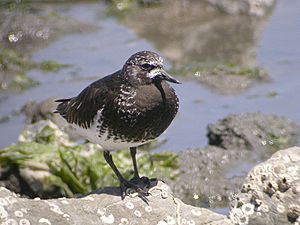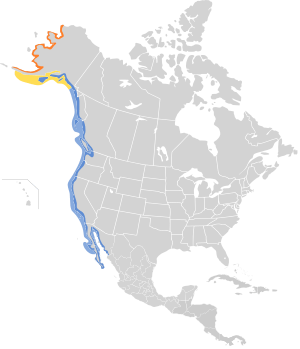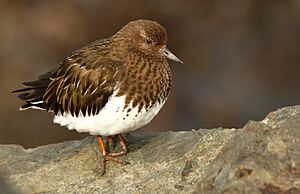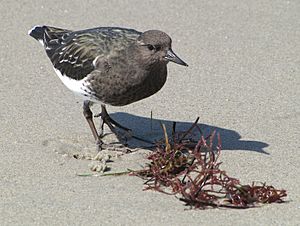Black turnstone facts for kids
Quick facts for kids Black turnstone |
|
|---|---|
 |
|
| Breeding-plumaged adult in Alaska | |
| Conservation status | |
| Scientific classification | |
| Genus: |
Arenaria (bird)
|
| Species: |
melanocephala
|
 |
|
| Synonyms | |
|
|
The black turnstone (Arenaria melanocephala) is a small wading bird. It lives along the west coast of North America. These birds are known for their unique way of finding food. They often turn over stones and other objects with their beaks! Black turnstones breed only in Alaska. They are related to another bird called the ruddy turnstone. Both are part of the Arenaria group.
Contents
What Does a Black Turnstone Look Like?

Black turnstones are about 22–25 centimeters (9-10 inches) long. They weigh between 100 and 170 grams (3.5-6 ounces). Their black bill is about 20–27 millimeters long. It curves slightly upwards. Their legs and feet are a dark brownish-black with a reddish tint.
These birds are mostly black and white. When they are ready to breed, their heads and chests are black. They have a white spot near their eye and a white stripe above it. White flecks appear on the sides of their chest. Their upper body is brownish-black. Their belly and bottom are white.
When they fly, you can see a white stripe on their wings. They also have a white patch on their shoulder. Their tail is white with a wide black band. The area from their lower back to their upper tail is white. There is a dark bar across their rump.
In winter, their heads and chests become mostly dark brown. They have less white color. Young birds look like winter adults. But they are browner. Their wing and shoulder feathers have buff (pale yellowish-brown) edges. The tip of their tail is grey-brown.
How is it Different from the Ruddy Turnstone?
The ruddy turnstone looks similar. But it has reddish-brown marks on its upper body. It also has more white on its head and chest. This is especially true when it's ready to breed. The ruddy turnstone has narrower wings. Its white wing stripe is also narrower. Its legs are orange and brighter. However, sometimes their leg colors can look similar.
What Sounds Do They Make?
Black turnstones make many different sounds. One common sound is a rattling trill. You can hear this sound all year round. This trill is higher and less harsh than the ruddy turnstone's call. They also make a loud, screeching alarm call. When they talk to their young chicks, they make a soft, purring sound. Male birds trying to attract a mate make special sounds. They produce a long series of short, sharp notes while flying. On the ground, they make chirping trills.
Where Do Black Turnstones Live?
Black turnstones breed in western Alaska. This area stretches from the Alaska Peninsula in the south. It goes up to Point Hope in the north. Most of these birds nest in the Yukon–Kuskokwim Delta. They usually build their nests near the coast. But sometimes they nest further inland. They can be found along the shores of rivers and lakes.
A few black turnstones have been seen in northeast Siberia. But there is no proof they breed there. Scientists believe there are about 95,000 black turnstones in the world. About 80,000 of them live in the Yukon-Kuskokwim Delta.
Where Do They Go in Winter?
In winter, black turnstones move south. They spend the colder months on rocky shores. These shores are along the Pacific coast of North America. Their winter home stretches from southern Alaska. It goes all the way south to northwest Mexico. In Mexico, they are found in Baja California and Sonora. There is one record of a bird seen in Nayarit.
Sometimes, they are seen inland during spring and fall. This happens when they are migrating. There are several records from the Salton Sea in southern California. They have also been seen in inland US states. These include Montana, Wisconsin, Nevada, and Arizona. Very rarely, a bird might wander far off course. These "vagrant" birds have been seen in Yukon and the Northwest Territories. One was even recorded on San Cristóbal Island in the Galápagos Islands.
How Do Black Turnstones Live?
Black turnstones mainly eat small invertebrates. In winter, they especially like crustaceans (like crabs) and mollusks (like snails). During the breeding season, they mostly eat insects. They also sometimes eat seeds, eggs, and dead animals.
On their breeding grounds, they mostly feed in wet meadows. These meadows have lots of sedge plants. In winter, they prefer rocky coasts. But they also look for food on beaches and mudflats. They can even be found on human-made structures. These include jetties and breakwaters. They use their strong bills to turn over stones. They also flip over mats of algae and other objects. This helps them find hidden prey underneath.
Breeding and Raising Young
Black turnstones arrive at their breeding grounds in early May or early June. The males usually arrive first. These birds often return to the same territory each year. They also often pair up with the same mate as in previous years.
The nest is a shallow dip in the ground. The male bird usually digs it. The nest is often hidden among sedges or grasses. Sometimes it's under willow bushes. The female usually lays four eggs. The eggs are olive or pale greenish. They have darker spots. Both parents take turns sitting on the eggs. This is called incubation. It lasts for 21–24 days.
The young birds are "precocial." This means they are quite developed when they hatch. They can leave the nest and find their own food soon after hatching. They learn to fly well after 25–34 days.
See also
 In Spanish: Vuelvepiedras oscuro para niños
In Spanish: Vuelvepiedras oscuro para niños



